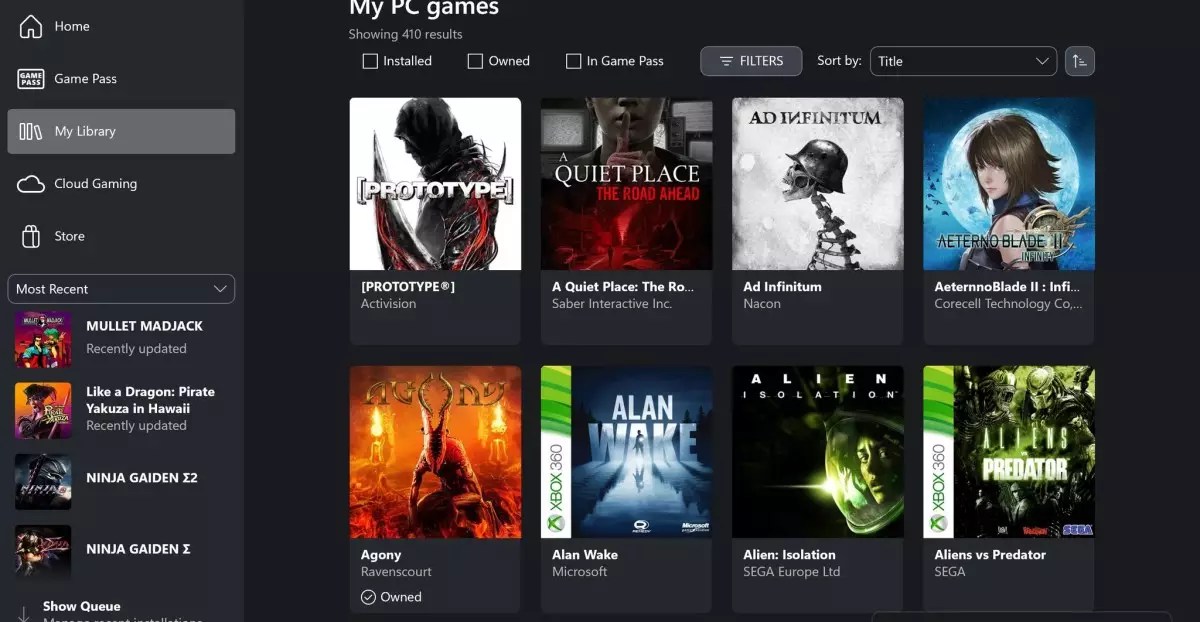In recent weeks, there has been palpable excitement within the gaming community regarding Microsoft’s evolving strategy to bridge the gap between its Xbox and Windows ecosystems. For many years, these two platforms have functioned somewhat independently. However, a recent development within the Xbox app on Windows signals a potential shift—a subtle but significant move that could redefine the gaming experience for millions. Senior editor Tom Warren has noted these changes in detail, suggesting that rather than simply a glitch, this shift reflects Microsoft’s broader ambitions to create a seamless gaming experience across devices.
Typically, users expect their Xbox console’s library to remain exclusive to the console itself. However, the unfolding situation with the Xbox PC app, which now showcases previously console-exclusive titles like “Alan Wake” as part of the users’ libraries, indicates a striking departure from the established norms of gaming accessibility. Warren’s insights suggest a deliberate path toward synthesizing the gaming experience on Windows and Xbox, which could serve as a significant advantage in an increasingly competitive gaming landscape.
The Shift Toward Integration
This trend towards integration isn’t merely a reaction to the current market dynamics; it is a proactive strategy aimed at creating a universal library of games. The proposed collaboration with Asus on Project Kennan hints at Microsoft’s forward-thinking initiatives. The notion of a unified gaming platform has the potential to disrupt the traditional monopolies upheld by competitors like Steam and Epic Games Store. By enhancing compatibility and visibility for games across platforms, Microsoft seems poised to lead the charge toward a more inclusive and comprehensive gaming ecosystem.
The early glimpses of Steam and Epic Games titles appearing in the Xbox app provide a tantalizing picture of what the future could hold. Instead of forcing players to juggle multiple launchers and libraries, Microsoft appears committed to fostering an environment where all gaming experiences coexist harmoniously under one digital roof. This is not merely a convenience for gamers; it could set a new standard for PC gaming, positioning Microsoft’s Xbox app as the go-to hub for everything gaming-related on Windows.
Brand Evolution and Market Strategy
Additionally, the rebranding of the Xbox PC app to simply “Xbox PC” illustrates a conscious effort to instill brand consistency and clarity within Microsoft’s gaming narrative. The strategic release of media assets that promote this branding during major game announcements further reinforces the company’s commitment to this vision. Microsoft has set the stage for a future where PC gamers will not only have access to traditional Microsoft Store titles but can also engage with a larger library of games previously siloed within console ecosystems.
With competitors like Lenovo exploring the realm of handheld gaming, Microsoft’s integration of Xbox and Windows becomes an even more critical component of its strategy. The addressable market for handheld gaming is vast, and the risk of falling behind is palpable. By advancing initiatives that blend the strengths of both platforms, Microsoft is not just responding to current trends but is anticipating future gaming paradigms.
The Cloud Gaming Frontier
Of course, these revolutionary changes raise several questions, most notably about the actual functionality of Xbox console titles on PCs. The possibility of playing exclusive games on your computer invites a discussion about cloud infrastructure—something Microsoft has invested in heavily. The potential of leveraging cloud technology to bridge compatibility gaps could mean that older console titles might finally make their way to PC without needing complex emulators.
As the gaming community watches closely, the pressure mounts for Microsoft to deliver on its ambitious promises. A successful rollout could not only capture the attention of console gamers but may also sway PC gamers who have traditionally relied on platforms like Steam. Microsoft’s evolution from separate platforms to an interconnected gaming ecosystem is more than just a technical upgrade; it’s a pivotal moment that could change the dynamics of the gaming industry.
By recognizing and addressing the diverse needs of today’s gamers—those who wish to play on consoles, PCs, and handhelds alike—Microsoft has the potential to drive digital innovation in the industry. The interweaving of Xbox and Windows signals not just a strategic maneuver but a bold new chapter in gaming that many have long awaited.


Leave a Reply